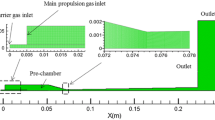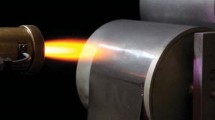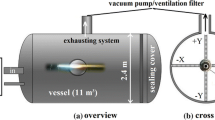Abstract
Electrochemical properties of Lithium Ferrous Phosphate (LFP or LiFePO4) make it a promising cathode material for lithium-ion batteries in electric vehicle applications. Spray drying is often used for manufacture of LFP cathode powder as the method results in particles of uniform size and with favorable structure. Analyzing the heat and mass transfer characteristics during a spray drying process through experiments is expensive and involves tedious measurements and methods. This paper presents a computational fluid dynamics study of heat and mass transfer characteristics of spray drying process. The technique uses a 2D axisymmetric model that mimics a drying chamber of 0.25 m in diameter and 0.6 m in height to study the spray drying behavior. The working pressure and the flow rate required as input for the computational domain were obtained experimentally with the use of distilled water spray through a full cone nozzle. The computational model is validated with experimental data on water spray and extended for the LFP precursor. The variation of the mass fractions of the multi-component substance (LFP and water) and the influence of the pumping pressure and temperature of the carrier gas are discussed. Increased pumping pressure allows fine atomization and consequently reduces the drying time. The analysis enables better understanding of the spray drying mechanism and is helpful during spray dryer design.











Similar content being viewed by others
REFERENCES
Jung, D.S., Hwang, T.H., Bin Park, S., and Choi, J.W., Spray Drying Method for Large-Scale and High-Performance Silicon Negative Electrodes in Li-Ion Batteries, Nano Lett., 2013, vol. 13, no. 5, pp. 2092–2097; DOI: 10.1021/nl400437f.
Gao, F., Tang, Z., and Xue, J., Preparation and Characterization of Nano-Particle LiFePO4 and LiFePO4/C by Spray-Drying and Post-Annealing Method, Electrochim. Acta, 2007, vol. 53, no. 4, pp. 1939–1944; DOI: 10.1016/j.electacta.2007.08.048.
Vertruyen, B., Eshraghi, N., Piffet, C., Bodart, J., Mahmoud A., and Boschini, F., Spray-Drying of Electrode Materials for Lithium- and Sodium-Ion Batteries, Materials (Basel)., 2018, vol. 11, no. 7; DOI: 10.3390/ma11071076.
Freitas, C. and Müller, R. H., Spray-Drying of Solid Lipid Nanoparticles (SLN(TM)), Eur. J. Pharm. Biopharm., 1998, vol. 46, no. 2, pp. 145–151; DOI: 10.1016/S0939-6411(97)00172-0.
Desobry, S.A., Netto, F.M., and Labuza, T.P., Comparison of Spray-Drying, Drum-Drying and Freeze-Drying for \(\beta\)-Carotene Encapsulation and Preservation, J. Food Sci., 1997, vol. 62, no. 6, pp. 1158–1162; DOI: 10.1111/j.1365-2621.1997.tb12235.x.
Huang, L., Kumar, K., and Mujumdar, A.S., A Parametric Study of the Gas Flow Patterns and Drying Performance of Co-current Spray Dryer: Results of a Computational Fluid Dynamics Study, Dry. Technol., 2003, vol. 21, no. 6, pp. 957–978; DOI: 10.1081/DRT-120021850.
Cotabarren, I.M., Bertı́n, D., Razuc, M., Ramı́rez-Rigo, M.V., and Piña, J., Modelling of the Spray Drying Process for Particle Design, Chem. Eng. Res. Des., 2018, vol. 132, pp. 1091–1104; DOI: 10.1016/ j.cherd.2018.01.012.
Ducept, F., Sionneau, M., and Vasseur, J., Superheated Steam Dryer: Simulations and Experiments on Product Drying, Chem. Eng. J., 2002, vol. 86, nos. 1/2, pp. 75–83; DOI: 10.1016/S1385-8947(01)00275-3.
Jüstel, M., Schwinger, A., Friedrich, B., and Binnewies, M., Synthesis of LiFePO4 by Ultrasonic and Nozzle Spray Pyrolysis, Zeitschrift fur Phys. Chemie, 2012, vol. 226, no. 2, pp. 177–183; DOI: 10.1524/ zpch.2012.0147.
Langrish, T.A.G. and Kockel, T.K., The Assessment of a Characteristic Drying Curve for Milk Powder for Use in Computational Fluid Dynamics Modelling, Chem. Eng. J., 2001, vol. 84, no. 1, pp. 69–74; DOI: 10.1016/S1385-8947(00)00384-3.
Phoungchandang, S. and Sertwasana, A., Spray-Drying of Ginger Juice and Physicochemical Properties of Ginger Powders, Science Asia, 2010, vol. 36, no. 1, pp. 40–45; DOI: 10.2306/scienceasial513-1874.2010.36.040.
Fang, Z. and Bhandari, B., Effect of Spray Drying and Storage on the Stability of Bayberry Polyphenols, Food Chem., 2011, vol. 129, no. 3, pp. 1139–1147; DOI: 10.1016/j.foodchem.2011.05.093.
Goula, A.M. and Adamopoulos, K.G., A New Technique for Spray Drying Orange Juice Concentrate, Innov. Food Sci. Emerg. Technol., 2010, vol. 11, no. 2, pp. 342–351; DOI: 10.1016/j.ifset.2009.12.001.
Osorio, C., Forero, D.P., and Carriazo, J.G., Characterisation and Performance Assessment of Guava (Psidium Guajava L.) Microencapsulates Obtained by Spray-Drying, Food Res. Int., 2011, vol. 44, no. 5, pp. 1174–1181; DOI: 10.1016/j.foodres.2010.09.007.
Schmitz-Schug, I., Foerst, P., and Kulozik, U., Impact of the Spray Drying Conditions and Residence Time Distribution on Lysine Loss in Spray Dried Infant Formula, Dairy Sci. Technol., 2013, vol. 93, nos. 4/5, pp. 443–462; DOI: 10.1007/s13594-013-0115-8.
Wen, S., Li, G., Ren, R., and Li, C., Preparation of Spherical Li4Ti5O12 Anode Materials by Spray Drying, Mater. Lett., 2015, vol. 148, pp. 130–133; DOI: 10.1016/j.matlet.2015.02.061.
Eftekhari, A., LiFePO4/C Nanocomposites for Lithium-Ion Batteries, J. Power Sources, 2017, vol. 343, pp. 395–411; DOI: 10.1016/j.jpowsour.2017.01.080.
Bewlay, S.L., Konstantinov, K., Wang, G.X., Dou, S.X., and Liu, H.K., Conductivity Improvements to Spray-Produced LiFePO4by Addition of a Carbon Source, Mater. Lett., 2004, vol. 58, no. 11, pp. 1788–1791; DOI: 10.1016/j.matlet.2003.11.008.
Versteeg, H.K. and Malalasekera, W., Introduction to Computational Fluid Dynamics, 1995, vol. 43, no. 8.
Fletcher, C.A., Computational Techniques for Fluid Dynamics, 1992, vol. 70, no. 1.
ANSYS Fluent Theory Guide, ANSYS Inc., USA, 2020, vol. 15317, pp. 724–746.
Ranz, W., Evaporation from Drops 1, Chem. Eng. Prog., 1952, vol. 48, no. 3. pp. 141–146.
Spalding, D.B., The Calculation of Mass Transfer Rates in Absorption, Vaporization, Condensation and Combustion Processes, Proc. Inst. Mech. Eng., 1954, vol. 168, no. 1, pp. 545–570; DOI: 10.1243 /pime_proc_1954_168_054_02.
Maruyama, Y. and Hasegawa, K., Evaporation and Drying Kinetics of Water-NaCl Droplets via Acoustic Levitation, RSC Adv., 2020, vol. 10, no. 4, pp. 1870–1877; DOI: 10.1039/c9ra09395h.
Author information
Authors and Affiliations
Corresponding author
Rights and permissions
About this article
Cite this article
Rajasekar, K., Raja, B. Investigation on Heat and Mass Transfer in Spray Drying Process. J. Engin. Thermophys. 30, 433–448 (2021). https://doi.org/10.1134/S1810232821030085
Received:
Published:
Issue Date:
DOI: https://doi.org/10.1134/S1810232821030085




